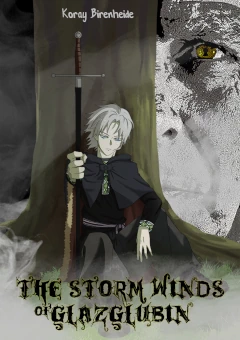
A traditional tafatolu1The Maoloaiya word for their special two-keeled canoe literally means "triangle", which refers to the shape of the sail that has come to be associated with their ships over the ages.sail set before the starry gates of Yaomo and Omatu with the sea below. This symbol universally represents the Maoloaiya people and is recognized as such by them, giving it roughly the status of a national flag.


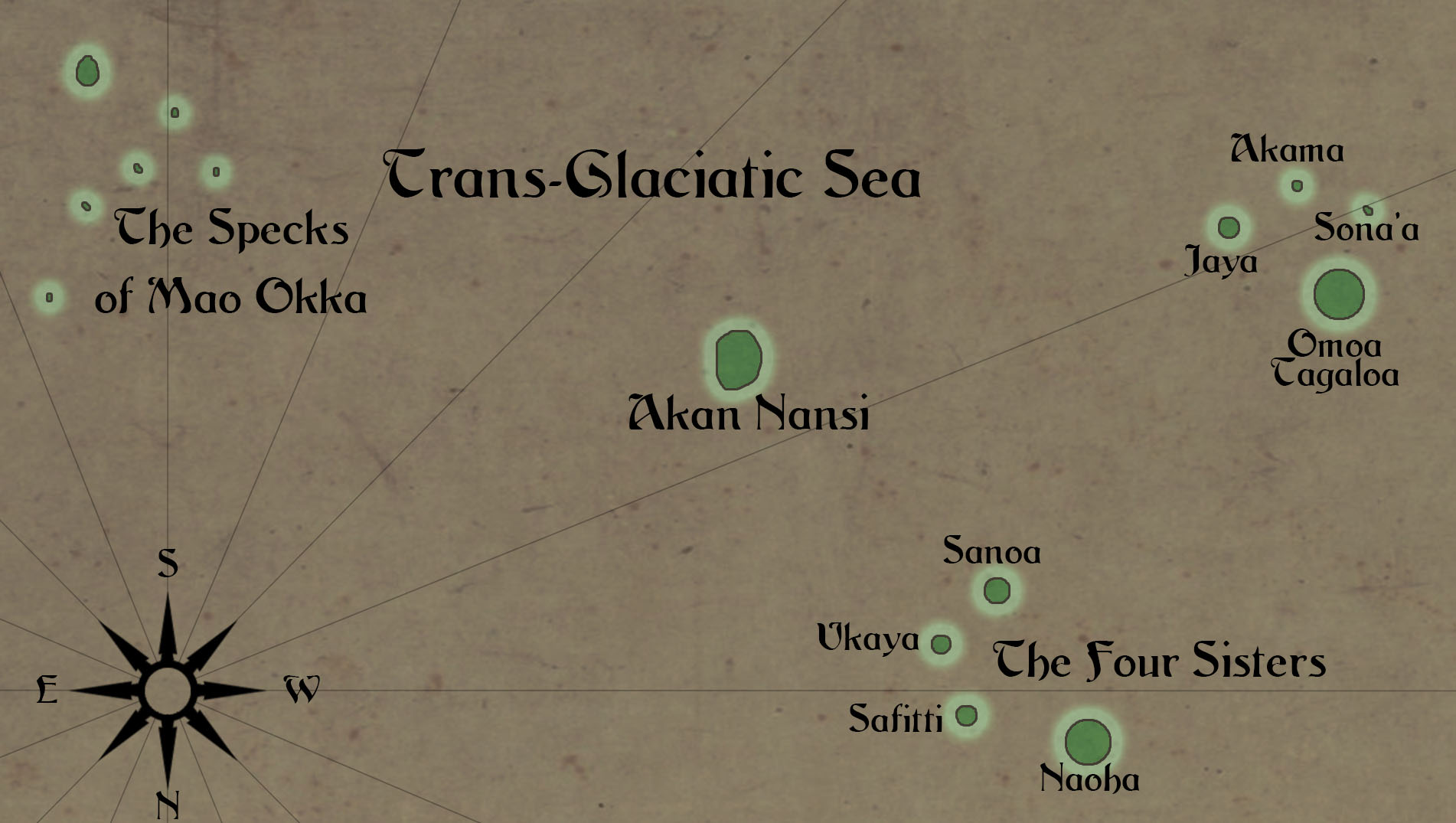

"You wish to voyage to my brothers across the ice?""Indeed I do!""Why?""Well, I... I am an anthropologist! I study other cultures!""Ah, so you are curious?""I suppose... you could put it that way.""Then you have that in common with my people. It was curiosity that brought them to those far away seas and us to these islands. Perhaps it is time to cross the great glacier. Exchange recipes and whatnot.""R...recipes?""Sure, why not? My people have a saying: Any excuse is good enough to travel. I will organize an expedition, my friend. We will leave in three days."
In 23 AA2The Age of Awakening was the third age After the Reshaping. It began 5700 ARe and lasted for about 200 years., the Nyingma monk and anthropologist Vajabandhu traveled to Ainan to converse with the Wavemaster of Ka Hale Akamai and seek records and oral traditions about the Maoloaiya people. Specifically, he wanted to know about those who had left the Corsic Ocean for the Trans-Glaciatic Sea. After a long stay on the pristine island, Vajabandhu and Wavemaster Urutu mounted an arduous expedition eastward across the Corsic together with twenty other Ainansi and a small fleet of five large tafatolu canoes to seek out and cross the Gastropnir Glacier, traveling across nearly two thousand kilometers of unforgiving ice and severe magical hazards. They never returned from their voyage, though unconfirmed sources suggested that they indeed reached the Trans-Glaciatic Sea but chose to stay with the Maoloaiya who lived there.

Maoloaiya (or "Ku Maoloaiya" in the Maoloaiya tongue)
Original Language
No3
Linguistic Characteristics
The Maoloaiya tongue is heavy on double vowels, especially "ao", "oa", "ai", and "uo"
Government
Independent tribes which freely assimilate other tribe members.
Homelands
The Ainan Island Group and the Trans-Glaciatic Sea
Table of Contents
I - Names and Rites of Passage
II - Living on the Trans-Glaciatic
III - History of the Maoloaiya
IV - Technological Traditions
V - Famous Maoloaiya People
Related Reading
Maoloaiya Culture: Names and Rites of Passage
| Effala | Vanna | Fannie |
| Saola | Safitti | Kaola |
| Whetu | Makutu | Maia |
| Yaomu | Omatu | Tupai |
| Tapi | Hamahona | Atua |
| Laori | Loati | Taanga |
Maoloaiya do not technically have last names because families on the island are not culturally separated from each other so that everyone considers everyone their brother and sister. However, in Maoloaiya culture, the idea of one's "origin" is significant because the Maoloaiya people travel and migrate between islands frequently. Because of this, they will generally take up the name of their birth island as a sort of last name. So, possible full Maoloaiya names could be: Omatu of Ainan, Kaola of Sona'a, or Kaya of Ukaya. Those born on the sea either take up the origin of their parents or say they are "of Moana", which means "of the sea".
The Tafatolu

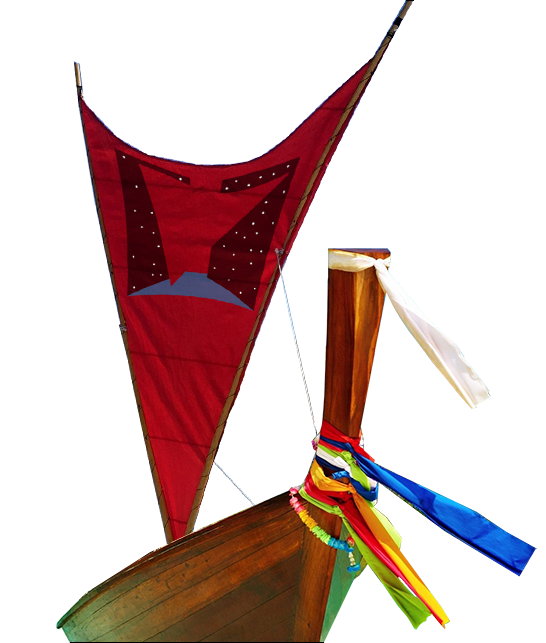
Growing Up


Ramarie felt the breeze picking up slowly behind her and saw it as a sign of Omatu's approval. She carefully stowed the paddle and stood up nimbly, barely rocking the steady canoe. She drew down the lower sail arm, unfurling the tafatolu, which bulged against the wind, infusing the canoe with great vigor as it sped towards the coast. Everyone was waiting for her return, waving, and excitedly holding up garlands of flowers they had picked during the morning. With a sudden rush and foomp, the bottom of the canoe slid out of the water and onto the bright sand. They all gathered around Ramarie with great cheers, touching her shoulders and adorning her with flowers. She could not stop grinning, a warm feeling of pure joy in her belly. She had passed the test! She had sailed around the island all on her own! Her tama and her tina4Mother and father.had unfastened the tafatolu from the mast sticks and now draped it over her shoulder with big smiles on their faces. "Pakeke5Here: "You are an adult"., Ramarie!" her tina said with pride in his voice. She hugged him with tears swelling in her eyes. "Name your tafatolu!" he tama cried with a bright grin on her beautiful face. "Name it! Name it!" called others. "Then I will name it!" Ramarie replied, touching the sail draped over her shoulders. "When I saw you all at the shore, I felt Omatu's breath behind me, so to honor him, I will name my tafatolu Omatubaluga!" More cheers errupted, many taking up the name and calling it out, while others sang the Omatu Tala, one of the popular Omatu songs. "Tonight, we feast!" Ramarie's tama said lovingly. "And tomorrow I will show you how to take good care of Omatubaluga. He will accompany you on many journeys."
Maoloaiya Culture: Living on the Trans-Glaciatic
Sociopolitical Dynamics
Within the tribe, all who have passed the first trial are considered equals amongst each other. Those who have not become wavemasters yet may not have the freedom to leave the island as they please, but this is not to patronize them but a sincere expression of worry for their safety by their elders. The sea can be treacherous, and the Maoloaiya would rather not see their beloved kinsmen venture out onto it without magic to protect them from its wiles. When there are decisions to be made that affect all of the tribe, the voices of anyone with their own tafatolu will be heard and duly considered by their peers. The islands on which the Maoloaiya live may have anywhere from one to several villages. If there is more than one, each village will generally have one village head to represent them and to help guide the village. Above that or instead if there is only one village, there is one chief per island, who, among other duties, is in charge of monitoring and assessing the resources of the island and surrounding sea as well as the coming and going of the seasons. He or she decides when it is time for the tribe to pack up and sail on to a different island so the current one may recover from the touch of human hands and replenish itself.The Life of a Maoloaiya
Wherever a Maoloaiya is born, brought, or wherever they travel, they will always be considered a part of the tribe they currently live with. A common Maolaiyan saying is:Brother, sister, across the sea, Sister, brother, next to me.It means that all Maoloaiya, wherever they may be, are each other's brethren, and they are generally extremely welcoming of tribesmen from wherever they come in. Rather than being ostracized, newcomers to an island are considered rich in new stories, a valuable currency in Maolaiyan society. During the first few years of a Maoloaiya's childhood, they will generally follow the mother around everywhere, a behavior called tamae, which resembles the similarly structured amae of the Yamato culture. The similarity of the two words is considered a coincidence. Unlike Yamato children, which are expected to subconsciously pick up on the countless fine points of Yamato etiquette, the cultural etiquette of the Maolaiyans is far less complex and strict. Living their lives in warm, sea-side climates, cut off from the ever more quickly evolving outside world owing to the great Gastropnir Glacier that encircles the Trans-Glaciatic Sea, the Maoloaiya are generally up-beat people with traditions geared towards the celebration of life, the weaving of tales, and the avid maintenance of oral tradition. As the child grows up, it begins to help out its parents with their chores: planting trees and shrubbery, harvesting them, buildings huts, canoes, and fish traps, making cloth out of fiber and weaving it into clothes and bags, diving for clams, crabs, and pearls, and whatever other duties serve the tribe. At any given time during a Maolaiyan's life, tribe migrations might take place, and they may spend prolonged times on the sea, during which their duties shift appropriately. When they succeed on their first trial and earn their tafatolu, it is expected of them to practice seafaring and learn pathfinding from their elders as well as begin to attune themselves to the ocean or the sky and unlock their magic. Once their magic is unlocked, they will be tested to become wavemasters, after which they are considered fully grown members of the tribe. At that point, they enjoy full freedom and may leave the tribe to sail to other shores if they so desire, but few ever do so permanently as the Maoloaiya foster a strong sense of duty and togetherness among each other. Still, young wavemasters will often band together to go on prolonged journeys to visit distant tribes for some time to explore the Trans-Glaciatic Sea and see new things.
Faith

"I have no need of your faith or anyone else's, but it is a potent lens through which the soul can light a mighty fire."An often ignored line in the scriptures of Yilik, the words of Jamphel Yeshe here hold great significance: Sincere Faith in another soul can project a significant amount of power onto it in a process called "soul power lensing" by Borealian clockwork theologists. The Maoloaiya people recognize the Great Clockwork as the grand arbiter of souls, facilitating the great cycle of reincarnation and often refer to it as manawa o te ao, "the breath of the world", which breathes souls into things. However, their faith and devotion is generally directed towards their ancestors and especially those ancestors who have accomplished great things. The Maoloaiya people often worship their forefathers for discovering islands, for overcoming times of scarcity, and for defeating evil animancers. Those few Maoloaiya who were Keepers of the Elements accomplished such great things for their people that they are universally worshipped by all Maoloaiya, funneling a not insignificant amount of soul power towards the Keepers and exerting a certain amount of Weird Pressure on their souls. Inside the Great Clockwork, several Pillar Souls can be attributed to the Maoloaiya faith, who have elevated some of their own within the fabric of the Great Clockwork. In turn, the Great Clockwork has generally looked favorable on the Maoloaiya people.
The Unusual Term
The Maoloaiya do not know the concept of sexual repression, and thanks to traditional, animantic cleansing rituals passed down through the generations, sexually transmitted diseases have not been a problem amongst their people. Though the concept of fatherhood was well established amongst the Vanier in the Old World and the Vanierkindern in the New World, over the ages of isolation on the Trans-Glaciatic Sea, the family-dynamic and parenthood changed somewhat. Of course, factually, children are conceived and carried to term by the Maoloaiya the same way they are everywhere, but the Maoloaiyan idea of pregnancy differs somewhat from the norm: They believe that children are souls that come down from the Great Clockwork into the wombs of women where they begin to grow. A man of the tribe will come forth and 'adopt' the child once the pregnancy begins, laying with the woman at least once a day to provide the milk until it is carried to term. Thereafter he will be the child's father.A Far-Reaching Retrospective
The Rise of the Tribes
"Mighty shamans once wielded these weapons before Odin smote them and sealed away the Keeper Blades beneath the vault of Skidbladnir, the conquered galleon of Frey. There they rested, sleeping but unbroken. Now they are restored to you! Cast your gazes closely on them, and those among you with souls to match their might will feel their call within their bones! Reclaim the magic of old and make this world a mighty one! I have cast its bones from the ashes of the Nine Realms, now you must be its blood and flesh it out in magic and ingenuity."
The Dawn of the Efalli
The Brammenwoods are located between Altonar and the Western Walls of Weltenend. They are the largest forest on Aqualon, larger even than the great Odenwald Forest. There are long vines that wind across the forest floor all the way from the Iron Belt; they are called dragontails and have tough iron scales with material sequestered from the Rusty Shore with powerful acidic roots. A "Bramma" is a semi-finished slab of steel, and the Brammenwoods get their name from the scales of the dragontails.

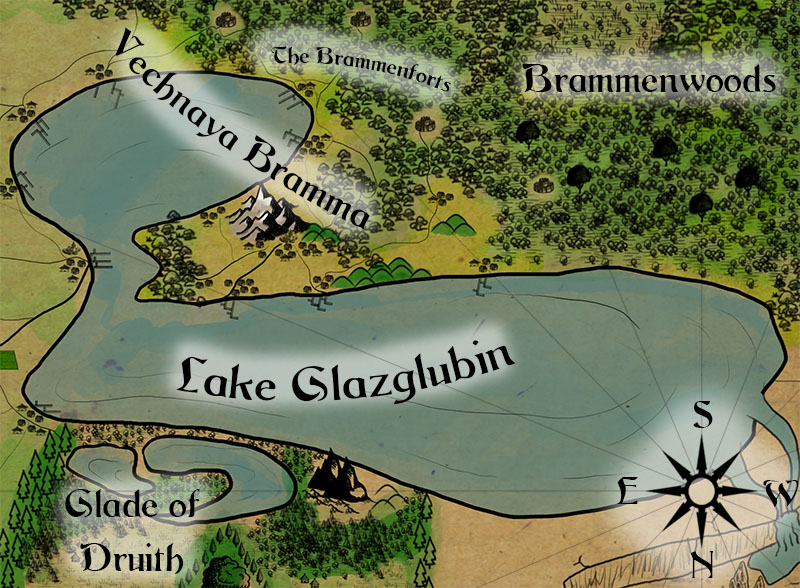


Legends of Ainan

The Departure of the Maoloaiya
When they returned, the Maoloaiya oral tradition states that they claimed they had found new islands for their people to explore. They raised a great gate from the sea floor up, and many of the Efalli sailed through it to a new ocean. They became the Maoloaiya, "those who's mothers are very far away". The new ocean they had reached was the Trans-Glaciatic Sea, which was tucked away behind the mighty Gastropnir Glacier, which cuts the Ocean Belt in half east of the Mandala Triangle. On this pristine new ocean, they settled the many islands they found and grew into a large and far-spread culture of nomadic seafarers, blessed with a powerful tradition of water and wind magic during the Age of the Iron Divide.
Technological Traditions

Traditional tafatolu canoes have one or two triangular sails with the tip pointing towards the hull. The ship itself usually has two keels, but can have up to two main keels and two side stabilizers, depending on how large it is. While the smaller tafatolu are used to navigate bays and coastal regions, often for fishing or circumnavigating islands to reach far-side settlements, the larger versions can travel impressive distances if managed properly. The very first canoes used by the Efalli had no sails but were propelled only with oars and the power of Efalla herself. When the Efalli reached the Ainan Island Group, they slowly developed their shipbuilding technology until the traditional tafatolu emerged and became a staple of Efalli and later Ainan and Maoloaiya culture. Tafatolu with two main keels made for long voyages have several larger sealed compartments, but usually no space "below deck" for people to retreat to; rather people would spend their time on deck. Generally, each large tafatolu, when taken far away from an island's shore, will be protected by a wavemaster, who can use wind or water magic to steady the sea and speed the ship on its way.

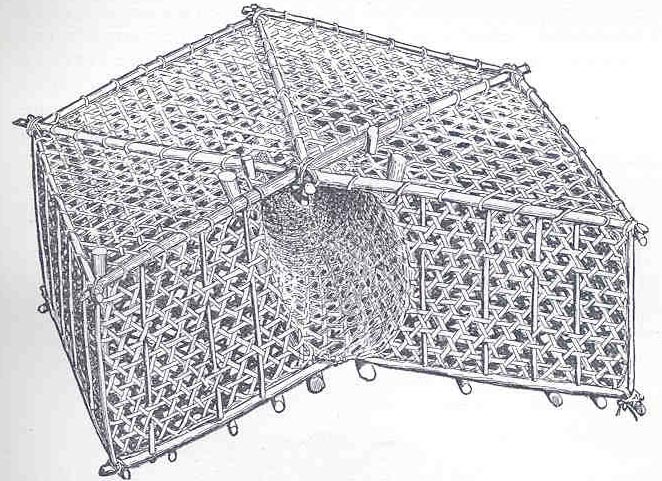
The iamailei is a fish trap made from bamboo, reed, or woven from palm fiber. Trapping fish is the main form of fishery practiced by the Maoloaiya.

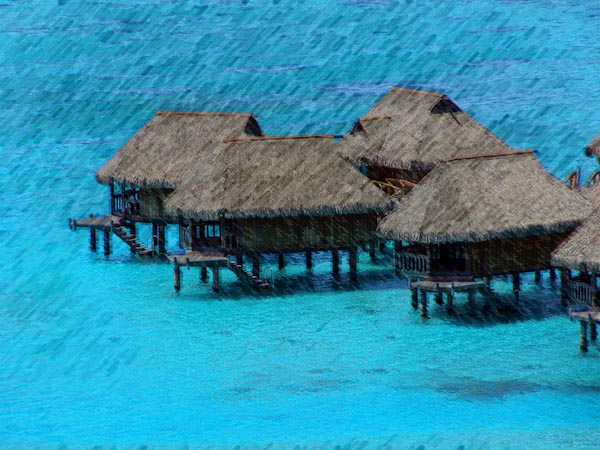
The faleiti is a hut constructed from timber, dried palm leaves, palm and coconut fiber, and brushwood. They are built in shallow waters near the coasts of islands to avoid clearing valuable land for living space. Rather than clearing trees for houses, the Maoloaiya will put their huts in the shallows and either swim to them or use canoes to travel between individual huts and the shore. Huts usually have hatches inside, which can be used as lavatories, but also as fishing holes. Though Maoloaiya fishery is usually done via nets and trapping, line fishing is a popular hobby and a family activity where a family will gather around the fishing hole to drink, converse, and - incidentally - catch fish.
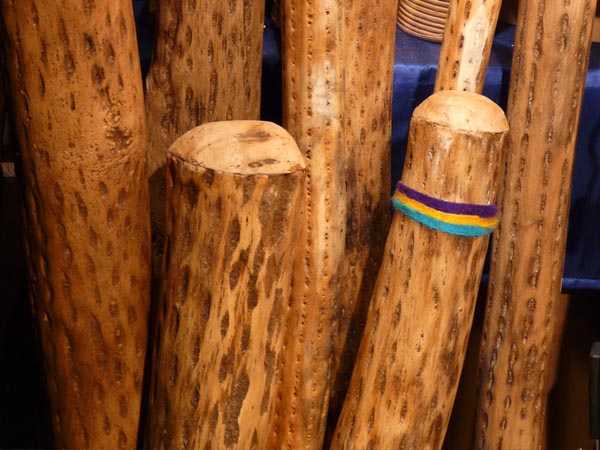
The te tote tote is a magical tool used to desalinate sea water. Not magical itself, the inner shape of the te tote tote is made to be conducive to water magic used to separate salt from water. This is done primarily to collect salt for cooking and pickling, but when fresh water is scarce, the excess distilled water is also collected for later use. While the wavemaster, which is the name for water mages among the Maolaiyan people, twirls the large staff, water is moved to one end by the centrifugal force and filtered using the inner shape of the te tote tote and water magic. When the process is complete, the wavemaster holds the staff over the ground or a vessel, where the water then trickles out of small holes until only salt remains in the staff.
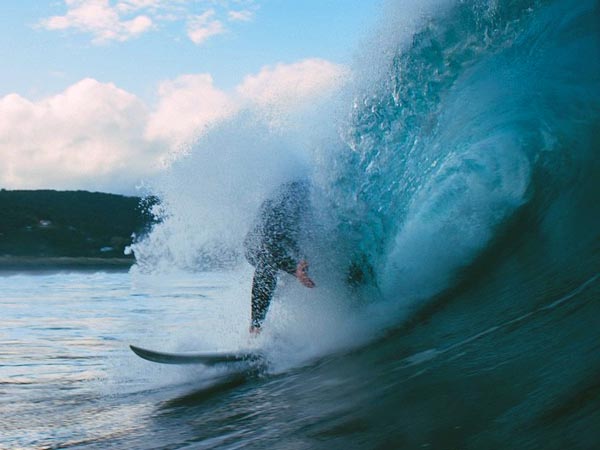
Waveriding is one of the most popular pastimes of the Moaloaiyan people. Swimming out on wooden surfing boards called kaiwhai, a waverider will attempt to catch a wave and surf it; then, if they know the Song of the Sea6"Knowing the Song of the Sea" is the Maoloaiya term for knowing how to perform water magic. Similarly, knowing how to perform wind magic is called "knowing the Song of the Sky"., they engorge the wave with their magic and control the water to perform amazing stunts on their boards. Sometimes waveriders will even work together to perform greater feats of magic and entertain their tribe with their amazing stunts and tall waves.




